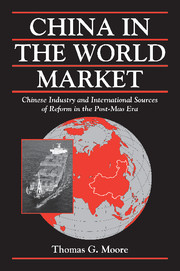Book contents
- Frontmatter
- Contents
- List of Figures
- List of Abbreviations
- Preface
- 1 China as a Latecomer in World Industrial Markets
- 2 The Outside World as an Impetus for Change in China
- 3 Tailor to the World: China's Emergence as a Global Power in Textiles
- 4 Beating the System with Industrial Restructuring: China's Response to the Multifiber Arrangement (MFA)
- 5 China Looms Large: Reform and Rationalization in the Textile Industry
- 6 Industrial Change in the Shadow of the MFA: The Role of Top-Level Strategy, Mid-Level Intervention, and Low-Level Demand in China's Textile Industry
- 7 Chinese Shipbuilding: The Modest Origins of an Emerging Industrial Giant
- 8 Dangerous Currents: Navigating Boom and Bust Cycles in International Shipbuilding
- 9 Chinese Shipbuilding and Global Surplus Capacity: Making a Virtue out of Necessity
- 10 Market-Oriented Solutions for Industrial Adjustment: The Changing Pattern of State Intervention in Chinese Shipbuilding
- 11 Who Did What to Whom?: Making Sense of the Reform Process in China's Shipbuilding Industry
- 12 External Shocks, State Capacity, and National Responses for Economic Adjustment: Explaining Industrial Change in China
- 13 China in the Contemporary International Political Economy
- Appendix Contours of the Research Effort
- Bibliography
- Index
Appendix - Contours of the Research Effort
Published online by Cambridge University Press: 07 August 2009
- Frontmatter
- Contents
- List of Figures
- List of Abbreviations
- Preface
- 1 China as a Latecomer in World Industrial Markets
- 2 The Outside World as an Impetus for Change in China
- 3 Tailor to the World: China's Emergence as a Global Power in Textiles
- 4 Beating the System with Industrial Restructuring: China's Response to the Multifiber Arrangement (MFA)
- 5 China Looms Large: Reform and Rationalization in the Textile Industry
- 6 Industrial Change in the Shadow of the MFA: The Role of Top-Level Strategy, Mid-Level Intervention, and Low-Level Demand in China's Textile Industry
- 7 Chinese Shipbuilding: The Modest Origins of an Emerging Industrial Giant
- 8 Dangerous Currents: Navigating Boom and Bust Cycles in International Shipbuilding
- 9 Chinese Shipbuilding and Global Surplus Capacity: Making a Virtue out of Necessity
- 10 Market-Oriented Solutions for Industrial Adjustment: The Changing Pattern of State Intervention in Chinese Shipbuilding
- 11 Who Did What to Whom?: Making Sense of the Reform Process in China's Shipbuilding Industry
- 12 External Shocks, State Capacity, and National Responses for Economic Adjustment: Explaining Industrial Change in China
- 13 China in the Contemporary International Political Economy
- Appendix Contours of the Research Effort
- Bibliography
- Index
Summary
A NOTE ON METHODOLOGY
Within the framework of industry-specific analysis, there are two basic methodological approaches that can be employed: large-n analysis (statistical examination of a large number of cases) or small-n analysis (in-depth studies of a small number of cases). While possible in the abstract, large-n analysis is not an especially good candidate for addressing the research agenda pursued in this book. First, the number of well-recorded case studies involving individual Chinese industries is quite small at present. Consequently, large-n analysis would require primary data collection for many industries. While basic information about many industries is supplied in national, provincial, and ministerial yearbooks, the available data varies widely on several counts: degree of detail, consistency of reporting practices, and the number of possible sources. While data on China's economy has been improving steadily, information remains incomplete in one respect or another for many industries. This was especially true for the 1980s, when reports on Chinese industries were still often superficial, haphazardly documented from year to year, and nearly impossible to verify even by the most rudimentary methods (e.g., comparing different sources). Simply put, there is not enough well-recorded data about a sufficient number of industries in order to conduct large-n analysis consistent with my research agenda.
Second, it can be argued that case-study analysis is simply better-suited for the task at hand.
- Type
- Chapter
- Information
- China in the World MarketChinese Industry and International Sources of Reform in the Post-Mao Era, pp. 316 - 321Publisher: Cambridge University PressPrint publication year: 2002



